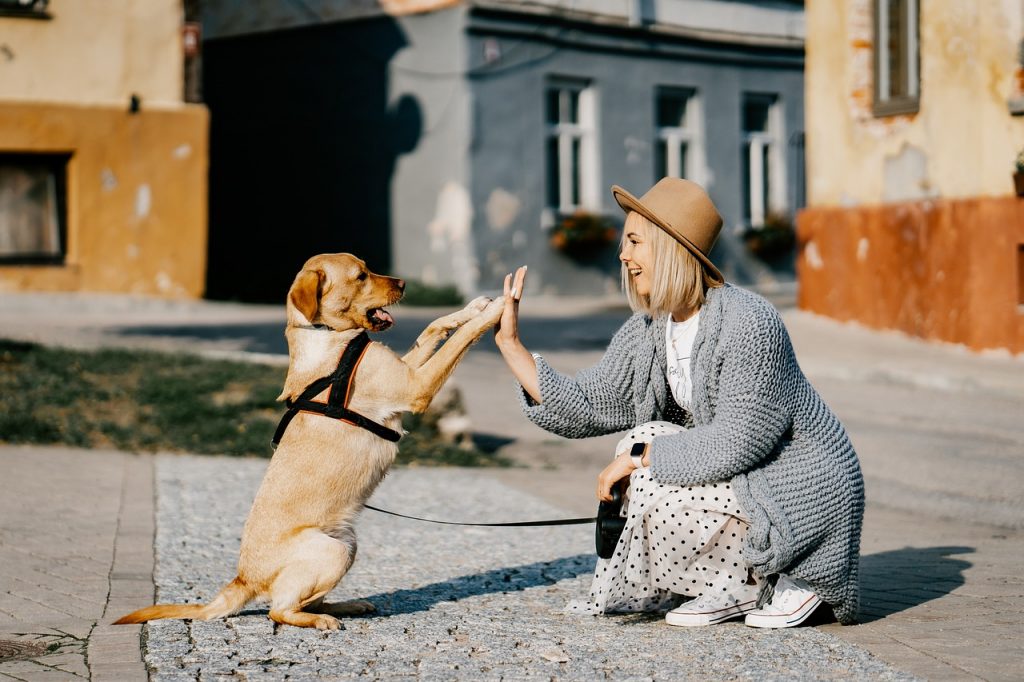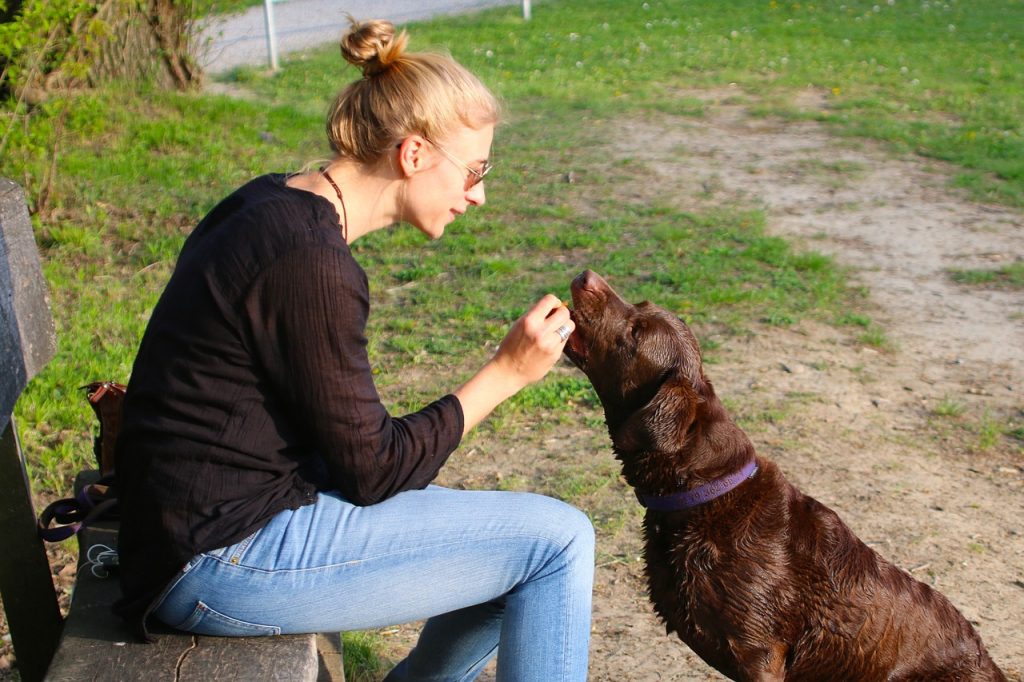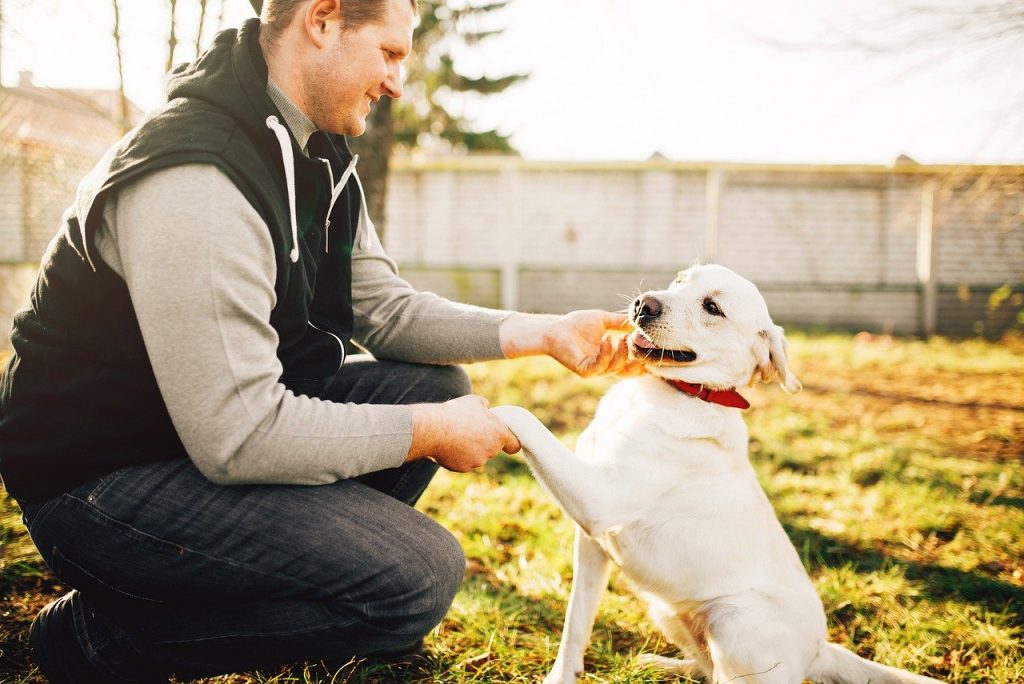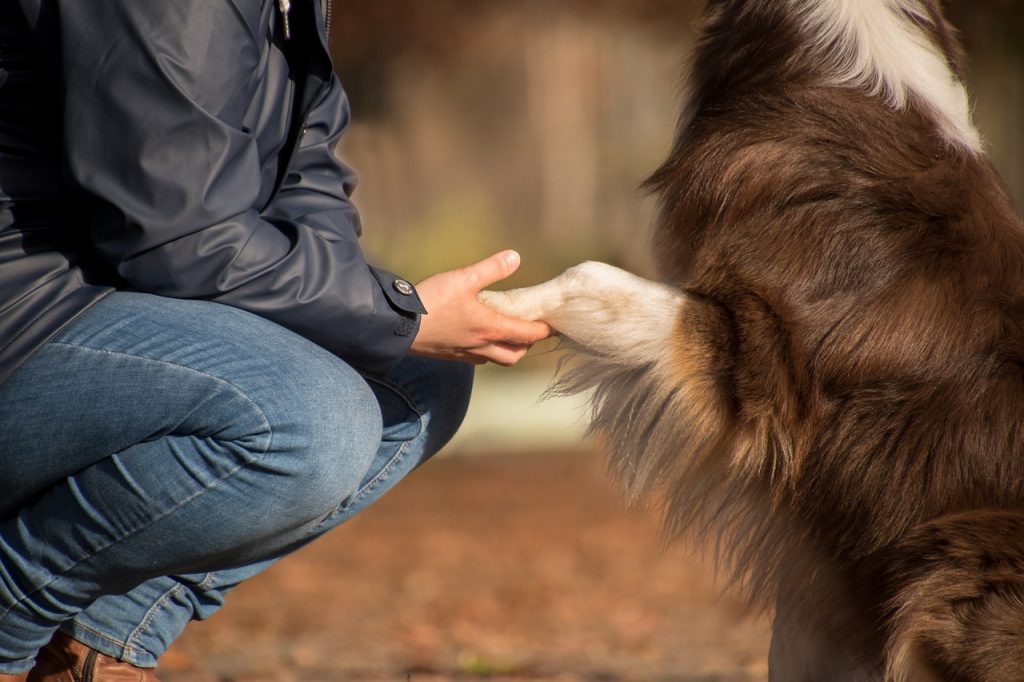Ever find yourself acting as a personal couch for your furry friend? Surprisingly, dogs standing or sitting on their owners is a common behavior. This blog will delve into the various reasons behind why does my dog stand on me.
Read on to decode why you’re often feeling the weight of Fido’s affection!

Key Takeaways
- Dogs stand on their owners to seek affection, attention, protection, display dominance, or show anxiety or comfort-seeking behavior.
- When a dog stands or leans on you, it shows love and trust. It’s their way of saying “I love you” and wanting to be close to you.
- Dogs standing on their owners can also indicate aggression, playfulness, bonding behavior, or influence from breed and personality traits.
- Owners can address and modify this behavior by setting boundaries, teaching proper behavior, providing alternative forms of affection and attention, and ensuring a safe environment for their dogs.
Reasons Why Dogs Stand on Their Owners
Dogs stand on their owners to seek affection, attention, protection, display dominance, or show anxiety or comfort-seeking behavior.
Seeking affection
Dogs stand on you to show love. They crave touch and warmth. When a dog leans or sits with all its weight on you, it says “I love you”. If your dog stands by your side on the couch, they are saying sweet words of affection.
It may seem funny when dogs lean on their owners with their backside. But even this is a sign of trust and love from them!
Seeking attention
Dogs may stand on their owners because they want attention. It’s their way of saying, “Hey, notice me!” When your dog stands on you, it’s a clear sign that they want your love and affection.
They crave your attention and want to be the center of your world. By standing on you, they are trying to get closer to you and make sure you don’t forget about them. So next time your furry friend stands on you, give them some extra cuddles and show them just how much you care.
Seeking protection
One reason why dogs stand on their owners is to seek protection. Dogs are naturally pack animals, and they often look to their human family for safety and security. By standing or leaning on their owners, they feel reassured and protected.
This behavior can also be seen as a way for dogs to show trust in their owners, relying on them for comfort and support. So if your dog stands or leans on you, it could be because they see you as their source of protection in the world.
Displaying dominance
Sometimes, when your dog stands or leans on you, it might be a way for them to show dominance. This behavior is more common in dogs that have a dominant personality or are trying to establish their place in the household hierarchy.
They may stand tall and look down at you to assert their position. It’s important to set boundaries with your dog and let them know that they should respect your personal space. By providing consistent training and enforcing rules, you can help create a balanced relationship where both you and your dog feel respected and secure.
Showing anxiety or comfort-seeking behavior
If your dog stands on you, it could be a sign of anxiety or a need for comfort. Dogs often seek closeness with their owners when they feel scared or uneasy. They may stand on you to feel secure and protected.
This behavior shows that your dog trusts you and looks to you for support. It’s important to provide them with a calm and reassuring environment where they can feel safe. Understanding their anxiety or comfort-seeking behavior will help you create a stronger bond with your furry friend.

Understanding the Different Messages Dogs Send with This Behavior
Dogs standing on their owners can relay different messages, such as affectionate behavior, aggression, bonding, playfulness, and personality traits influenced by breed.
Affectionate behavior
Dogs standing on their owners is often a way to show affection. When your dog stands or sits on you, they are seeking closeness and warmth. It’s their way of saying “I love you” and wanting to be close to you.
Dogs may lean against your legs or place their full weight on you as a sign of love and trust. So, next time your furry friend stands on you, know that it is their way of showing how much they care about you!
Aggressive behavior
Sometimes, a dog standing on you might not be a sign of affection or seeking attention. It could also be a display of aggression. Aggressive behavior in dogs can include growling, snarling, snapping, or biting.
If your dog is showing signs of aggression while standing on you, it’s important to address the issue as soon as possible for the safety of both you and your dog. Seek help from a professional trainer or behaviorist who can assess the situation and provide guidance on how to modify this aggressive behavior.
Remember that aggression should never be ignored and always needs to be addressed with care and caution for everyone involved.
Bonding behavior
Dogs standing on their owners can be a form of bonding behavior. When your dog stands or leans against you, it shows that they trust and feel close to you. It’s their way of showing affection and seeking comfort from your presence.
Dogs use this behavior to strengthen the bond between themselves and their owners. They also see it as a way to establish their place in the pack hierarchy, confirming their attachment to you as their leader.
This bonding behavior is a sign that your dog feels safe and secure with you, creating a deeper connection between the two of you. And hey, who doesn’t love some extra cuddles from our furry friends?.
Playful behavior
Dogs standing on their owners can also be a sign of playful behavior. When your dog is feeling playful, they may choose to stand or jump on you as a way to engage in interactive play.
It’s their way of saying, “Hey, let’s have some fun!” They may wag their tail and bounce around with excitement. Playing this way allows dogs to release energy and bond with their human companions.
It’s important to remember that dogs use their body language to communicate, and standing on you during playtime is just another way for them to show their enthusiasm. So next time your dog stands on you, get ready for some playful moments together!
Breed and personality influence
The breed and personality of your dog can also influence why they stand on you. Some breeds are naturally more affectionate and clingy, while others are more independent. For example, small lap dog breeds like Chihuahuas or Yorkshire Terriers may have a tendency to stand on their owners for attention because they crave close contact.
On the other hand, larger breeds like Great Danes or Newfoundlands may lean against their owners as a way to show love and seek comfort. It’s important to understand your dog’s individual personality and breed traits to better interpret their behavior when they stand on you.

Addressing and Modifying the Behavior of Dogs Standing on Their Owners
Owners can address and modify this behavior by setting clear boundaries, teaching proper behavior, providing alternative forms of affection and attention, and ensuring a safe and comfortable environment for their dogs.
Setting boundaries and teaching proper behavior
Teaching your dog proper behavior is important for setting boundaries and maintaining a harmonious relationship. Here are some tips to help you with this:
- Establish rules and consistency: Clearly communicate what behaviors are acceptable and what are not. Be consistent in enforcing these rules so that your dog understands what is expected of them.
- Use positive reinforcement: Reward your dog’s good behavior with praise, treats, or playtime. This will help reinforce their understanding of desired actions.
- Redirect unwanted behavior: If your dog starts standing on you when it’s not appropriate, gently redirect their attention to a more appropriate behavior or location. For example, give them a toy or move away from the area where they are standing.
- Provide alternative outlets: Make sure your dog has plenty of opportunities for exercise, mental stimulation, and socialization. This can help prevent them from seeking attention or displaying unwanted behaviors.
- Seek professional help if needed: If your dog’s standing behavior becomes excessive or problematic, consider consulting with a professional dog trainer or animal behaviorist for guidance and support.
Providing alternative forms of affection and attention
- Engage in interactive playtime with your dog, such as throwing a ball or playing tug-of-war.
- Give frequent verbal praise and petting to show your dog that they are loved and appreciated.
- Provide puzzle toys or treat – dispensing toys to mentally stimulate your dog and keep them occupied.
- Take your dog for regular walks or outdoor activities to give them physical exercise and mental stimulation.
- Incorporate training sessions into your daily routine to bond with your dog and provide mental stimulation.
- Set aside dedicated bonding time each day to spend quality time with your dog, such as cuddling on the couch or having a designated snuggle session.
- Provide different types of affection, such as gentle massages or grooming sessions, to create variety and enrich your dog’s experience.
- Show affection through actions like belly rubs, ear scratches, and chin rubs, based on what your dog enjoys.
- Offer appropriate treats as rewards for good behavior to reinforce positive interactions and show love and appreciation.
- Use positive reinforcement techniques, like clicker training or praising with treats, to reward desired behaviors from your dog.
Ensuring a safe and comfortable environment
To ensure a safe and comfortable environment for your dog, it’s important to create boundaries and teach them proper behavior. Provide them with their own designated space where they can feel secure and relax.
Make sure they have access to fresh water, nutritious food, and a cozy bed. Keep their living area clean by regularly cleaning up after them. Additionally, provide mental stimulation through toys, games, and interactive playtime.
Establish a routine that includes regular exercise to keep them physically healthy and mentally stimulated. Lastly, don’t forget about regular vet check-ups and vaccinations to ensure their overall well-being.

Conclusion
In conclusion, when your dog stands on you, it’s their way of showing affection and seeking attention. It can also indicate a sense of protection or dominance in some cases. Understanding your dog’s behavior and setting boundaries will help create a safe and comfortable environment for both of you.
So the next time your furry friend climbs up onto you, remember it’s just their special way of saying “I love you”.
FAQs
1. Why does my dog stand on me?
Your dog may stand or lean on you as a form of canine communication, showing love, seeking attention or feeling safe.
2. Is it normal for dogs to sit or stand on humans?
Yes, dogs often sit or lean against their owners to show affection and bond with them. This is part of their dog behavior and the human-animal connection.
3. What should I do if my giant breed dog stands on me?
If your giant dog breeds are standing too much on you, teach them boundaries regarding when it’s okay and where they can do so; like avoiding standing directly on chests but could instead stay close at your feet.
4. Do all dogs show affection by standing or leaning?
Not all dogs express feelings in the same way but many use body language such as sitting near you, leaning against you or even standing over laps to demonstrate pet bonding from canine instincts.
5. Does a clingy behavior indicate an issue if my dog keeps standing over me for food?
While need for food might be one reason, constant attention-seeking might also suggest that your pet feels insecure and needs more comfort.


